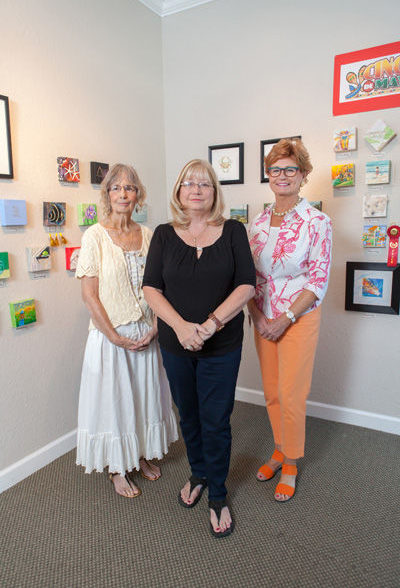
The Mexican holiday on the Fifth of May has given its name to a competitive exhibition currently on display at Artists Guild Gallery. “Cinco de Mayo” features, appropriately enough, five-by-five inch square artworks in oil, acrylic, watercolor and mixed media. Over 100 vividly colored works – punctuated here and there by ribbons for first, second and third place winners – hang in neat rows on the walls of the Guild’s front gallery.
Gale Orozco and co-chairs Penny Alieti and Dawn Mill organized this year’s show.
Orozco shares a surname with one of the most influential Mexican artists of the 20th century, José Clemente Orozco. Gale Orozco’s late husband was a grandnephew of the artist.
While the Artists Guild Gallery show has little to do with Mexican culture, its artworks celebrate luxuriant foliage and tropical fauna, seascapes, sandy beaches, palm-fringed landscapes and, for good measure, the occasional abstract composition.
The rules for the show specified that all entries could be no larger than five by five inches square. In art as in war, bigger is not necessarily better.
This is the second time the gallery has held a Cinco de Mayo exhibition; the first was in 2010. While the size limitation was the same, back then all entries had to be done on an unframed gallery wrapped canvas, and all the works were priced at $55. That changed for 2015.
This time artists were given the choice of working on varied supports, including wood panels and paper, and artists were given the option of mounting their work in frames, as long as the artwork itself did not exceed the size limitation. The artists were also allowed to price their works as they saw fit. Prices start at $55 and go up to $215 for the artworks; the majority are priced under $90.
According to Orozco, the relaxing of the rules made for a “different show entirely,” than the 2010 offering.
For her part, Orozco was delighted to use a new product for her entries, a hardboard panel made especially for watercolor.
“They didn’t have that five years ago,” she says.
Orozco’s paintings include a portrait of a cow with a pearl necklace, an alligator, a pair of elephants, and a rooster – the latter corralled behind a three-dimensional fence made of bits of wood and wire.
While a few of the artists went to the added trouble of framing and, in some cases, glazing their artworks, most stuck to presenting their gallery-wrapped canvases and cradled panels unframed. The 1¼ inch depth of those painting supports encouraged many of the artists to let their compositions continue around the edges and encompass the sides of the artworks.
Among those artists who chose to take advantage of that extra real estate was the competition’s first place winner, Gail Dolphin.
Her beautifully rendered watercolor of a green anole nestled among the leaves of a hot pink bougainvillea makes the most of the chunky format. Part of the lizard’s tail and an abundance of colorful foliage continue to the sides the piece, creating an effect as pretty as a gift-wrapped package.
Others who successfully used the wrap-around technique include Dawn Mill, who showcases her talent for detail with acrylic paintings of an egret flapping past a mangrove forest, and a sea turtle gliding through the deep blue; Marjorie Bohler, who offers a sun-splashed watercolor study of grapes on the vine, and Sue Guinn, whose mixed media assemblage features three bleached starfish skeletons against a red, purple and black torn paper collage.
If the exhibition had a prize for “cute,” Christina Aiton’s sensitive watercolor portrait of a little white-haired dog would win it paws down. The artist stretched the rules a bit, pasting a shaped piece of watercolor paper over the five-by-five support. That allows the ears of the dog to extend a bit past the square composition. The $65 bargain was snapped up by a buyer on opening night.
One of the artworks on display clearly addresses the culture behind the show’s theme. Resembling the centerpiece in a children’s pop-up book, Peter Laughton’s miniature Mexican fiesta is constructed of cut and layered paper. It is a street scene where mariachi musicians play and dancers twirl in front of a building that displays the Mexican tricolor and the words “Cinco de Mayo.” The lighthearted work was awarded a second-place ribbon in the show.
Third place in the exhibition went to Carol Makris, whose painting of a butterfly is set against a tracery of white plant forms. The painting is mounted in a simple, dark floater frame that sets it off like a rare specimen in a case.
Judy Rixom also chose to frame her entries in floater frames; a stand-out among them is the depiction of a magical bird with pink, blue and gold plumage.
Other small works that pack a punch disproportionate to their size is a series of eye-popping geometric abstractions by Joan Bence and a group of five mixed media works, three floral still lifes and two nature inspired abstracts by Penny Alieti. The saturated oranges, reds, yellows and magentas in Alieti’s energetic compositions will have you shouting “Viva Mexico!” before you know it.
“Cinco de Mayo” continues at the gallery through May 30.



